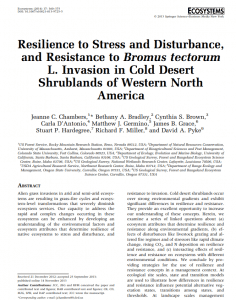Climate & Fire & Adaptation
View bibliography.
This bibliography reflects the growing interest in assisted migration, the intentional movement of plant materials in response to climate change, and provides a central foundation for collaboration in generating research questions, conducting studies, transferring and acquiring data, expanding studies to key species and geographic regions, and guiding native plant transfer in changing climates. It should inform management as the mismatch in rates between climate change and plant migration and adaptation pose significant challenges for natural resource managers, especially when scientific information often lags behind the demand for management actions.
View abstracts.
Abstracts of Recent Papers on Climate Change and Land Management in the West, Prepared by Louisa Evers, Science Liaison and Climate Change Coordinator, BLM, OR-WA State Office.
View abstracts.
Abstracts of recent papers on climate change and land management in the West. Prepared by Louisa Evers, Science Liaison and Climate Change Coordinator, Bureau of Land Management, Oregon-Washington State Office.
View article.
This study tested the stress-gradient hypothesis (SGH) in observations of 75 sites along overlapping water and heat stress and disturbance gradients. As stress-disturbance levels increase, sagebrush-herbaceous plant facilitation levels increase, the landscape will become increasingly aggregated as a product of necessary facilitation between sagebrush and herbaceous plants. This aggregation decreases the individual resilience of the native herbaceous plants, increases the competition from invasive plants, and decreases the overall stability and resilience of the sagebrush steppe ecosystem.
View abstracts.
Abstracts of recent papers on climate change and land management in the West. Prepared by Louisa Evers, Science Liaison and Climate Change Coordinator, Bureau of Land Management, Oregon-Washington State Office.
View abstracts.
Abstracts of recent papers on climate change and land management in the West. Prepared by Louisa Evers, Science Liaison and Climate Change Coordinator, Bureau of Land Management, Oregon-Washington State Office.
View article.
This study found that growth rate of cheatgrass increased in both warming and snowmelt treatments. Largest increases occurred in warming plots during the wettest year, indicating that the magnitude of response to warming depends on moisture availability. Results indicate that increasing temperature will exacerbate cheatgrass impacts, especially where warming causes large reductions in the depth and duration of snow cover.
View brief.
This research brief from the California Fire Science Consortium discusses that detrimental consequences from future fires under changing climates could be reduced by recognizing diverse adaptions to fire in different forest types and by preparing forests and people for larger and more frequent fires.
View review.
This review examines the effects of disturbances, such as grazing, and changes in climate on resilience and resistance of cold desert shrublands that span temperature and precipitation gradients across the western United States. It demonstrates how to use information about cold desert resilience and resistance to help manage this ecosystem and describes the benefits of using protection, prevention, restoration, and monitoring strategies to determine priority management areas and appropriate management actions.



